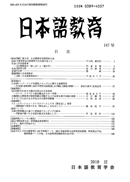Volume 139
Displaying 1-6 of 6 articles from this issue
- |<
- <
- 1
- >
- >|
FEATURED ISSUE
Featured Article
-
2008 Volume 139 Pages 1-11
Published: 2008
Released on J-STAGE: October 30, 2022
Download PDF (4723K) -
2008 Volume 139 Pages 24-35
Published: 2008
Released on J-STAGE: October 30, 2022
Download PDF (4796K) -
2008 Volume 139 Pages 36-41
Published: 2008
Released on J-STAGE: October 30, 2022
Download PDF (1919K)
REGULAR ISSUE
Research Papers
-
2008 Volume 139 Pages 42-51
Published: 2008
Released on J-STAGE: October 30, 2022
Download PDF (4086K)
Survey Articles
-
2008 Volume 139 Pages 52-61
Published: 2008
Released on J-STAGE: October 30, 2022
Download PDF (3785K)
Practical Articles
-
2008 Volume 139 Pages 72-81
Published: 2008
Released on J-STAGE: October 30, 2022
Download PDF (3935K)
- |<
- <
- 1
- >
- >|
